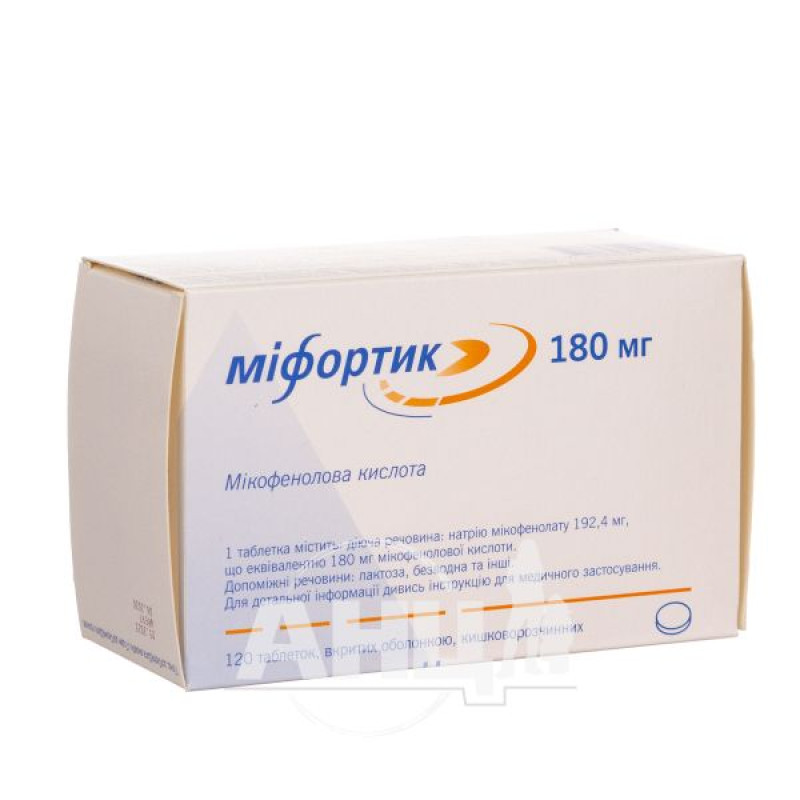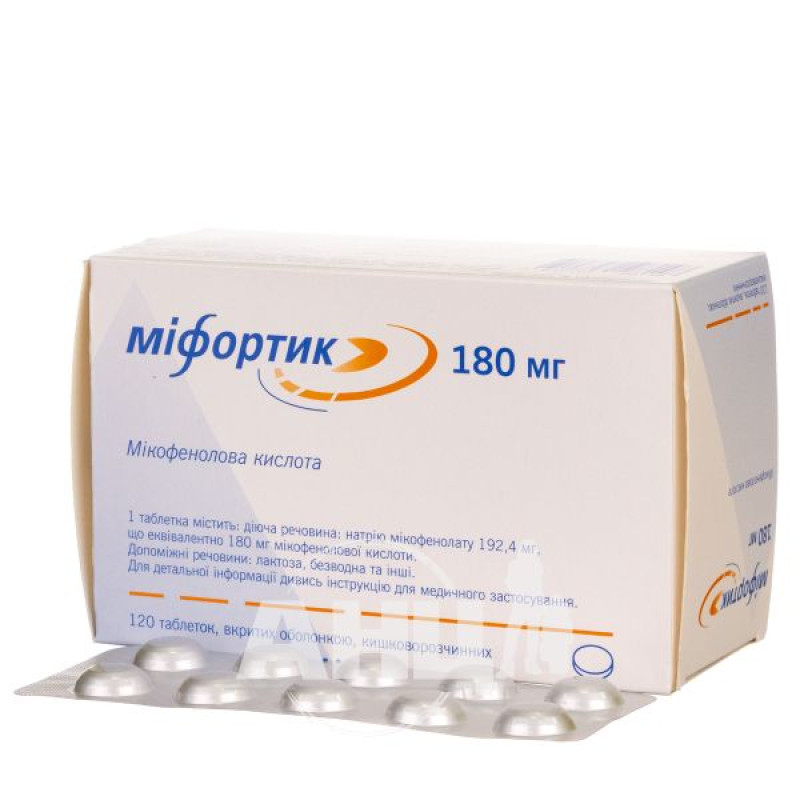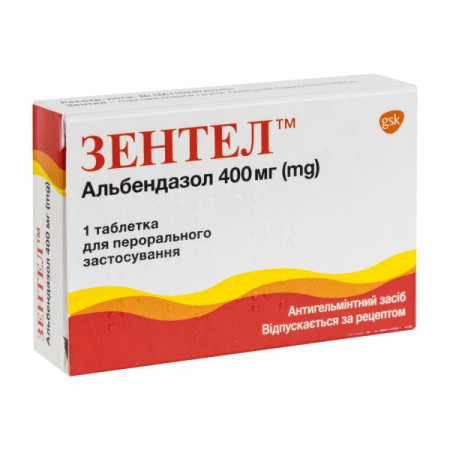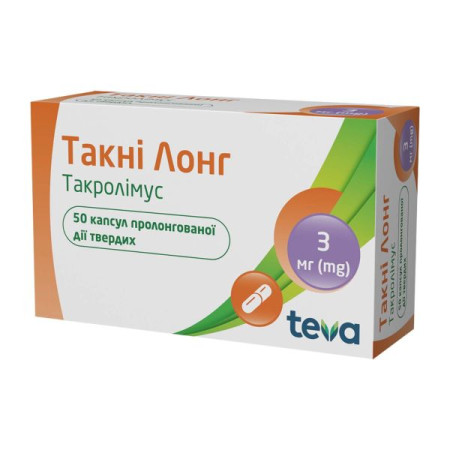Myfortic enteric-coated tablets 180 mg No. 120

The drug "Myfortic" in combination with cyclosporine (in the form of a microemulsion) and corticosteroids is indicated for the prevention of acute transplant rejection in patients with allogeneic kidney transplants.
Composition
The active substance is mycophenolic acid (as mycophenolate sodium) (one tablet contains 192.4 mg of mycophenolate sodium, which is equivalent to 180 mg of mycophenolic acid).
Excipients: tablet core - anhydrous lactose, crospovidone, povidone (K-30), corn starch, colloidal anhydrous silicon dioxide, magnesium stearate; shell - hypromellose phthalate, titanium dioxide (E 171), iron oxide yellow (E 172), indigo carmine (E 132).
Contraindication
Hypersensitivity to mycophenolate sodium, mycophenolate mofetil, lactose, galactose or any other component of the drug; pregnancy, alternative treatment should be used to prevent transplant rejection; breastfeeding; contraindicated in women of reproductive age not using highly effective methods of contraception; to avoid unwanted use during pregnancy, the drug is contraindicated in women who have not provided pregnancy test results.Method of application
Treatment with Myfortic should be initiated and maintained only by qualified transplant specialists. The recommended dose is 720 mg (4 tablets of 180 mg) twice daily (daily dose - 1440 mg). This dose of mycophenolate sodium corresponds to one gram of mycophenolate 2 times daily (daily dose - 2 g) in terms of mycophenolic acid content.
De novo patients should start taking Myfortic within 72 hours after transplantation.
The drug is used regardless of meals. Patients can choose any option for use, but must always adhere to the chosen option.
In order to maintain the integrity of the enteric coating, the tablets should not be crushed.
When tablet splitting is necessary, inhalation of the powder or direct contact of the powder with the skin or mucous membranes should be avoided.
If this happens, wash the area thoroughly with soap and water; rinse the eyes with clean water. This is due to the teratogenic effect of mycophenolate.
Treatment during transplant rejection: Transplant rejection does not alter the pharmacokinetics of mycophenolic acid (MPA), and no dose adjustment or discontinuation of the drug is required.
Application features
Pregnant women
The use of the drug "Myfortic" during pregnancy is contraindicated; taking the drug is possible only under the condition of reliable contraception.
Because of the potential for serious adverse reactions to mycophenolic acid in breastfed infants, the drug is contraindicated in women who are breastfeeding. Breastfeeding should be discontinued during treatment with Myfortic and for 6 months after completion of therapy.
There are no specific studies evaluating the effect of the drug on fertility in humans. In studies in male and female rats, no effect was found at doses of 40 mg/kg and 20 mg/kg, respectively.
Children
There is insufficient data on the safety and efficacy of the drug in children. Pharmacokinetic data in children with renal transplants are limited.
Drivers
There are no studies on the effects on the ability to drive and use machines. The mechanism of action of the drug, the pharmacodynamic profile and the reported side effects indicate a low probability of such an effect.
Overdose
Cases of intentional or accidental overdose have been reported, but not all patients experienced adverse reactions.
The adverse reactions that develop are consistent with the known safety profile of this class of compounds. Overdose of the drug may lead to excessive suppression of the immune system, resulting in increased susceptibility to infections, including opportunistic infections, fatal infectious diseases and sepsis. In the event of blood dyscrasias (e.g. neutropenia with an absolute neutrophil count <1.5 × 1023 / μl or anemia), it is advisable to temporarily suspend or cancel therapy with the drug "Myfortic".
Although dialysis can be used to remove the inactive metabolite of HMPC, it is not able to remove clinically significant amounts of the active component MPA. This is mainly due to the very high degree of binding of MPA to plasma proteins - 97%. Substances that enhance the excretion of bile acids, such as cholestyramine, by affecting the gastro-hepatic circulation of MPA, may reduce the systemic exposure of MPA.
Side effects
The most common adverse events were leukopenia (19.2%) and diarrhea (23.5%).
Storage conditions
Store in the original packaging to protect from moisture at a temperature not exceeding 30 °C, out of the reach of children.
Shelf life - 3 years.
There are no reviews for this product.
There are no reviews for this product, be the first to leave your review.
No questions about this product, be the first and ask your question.













